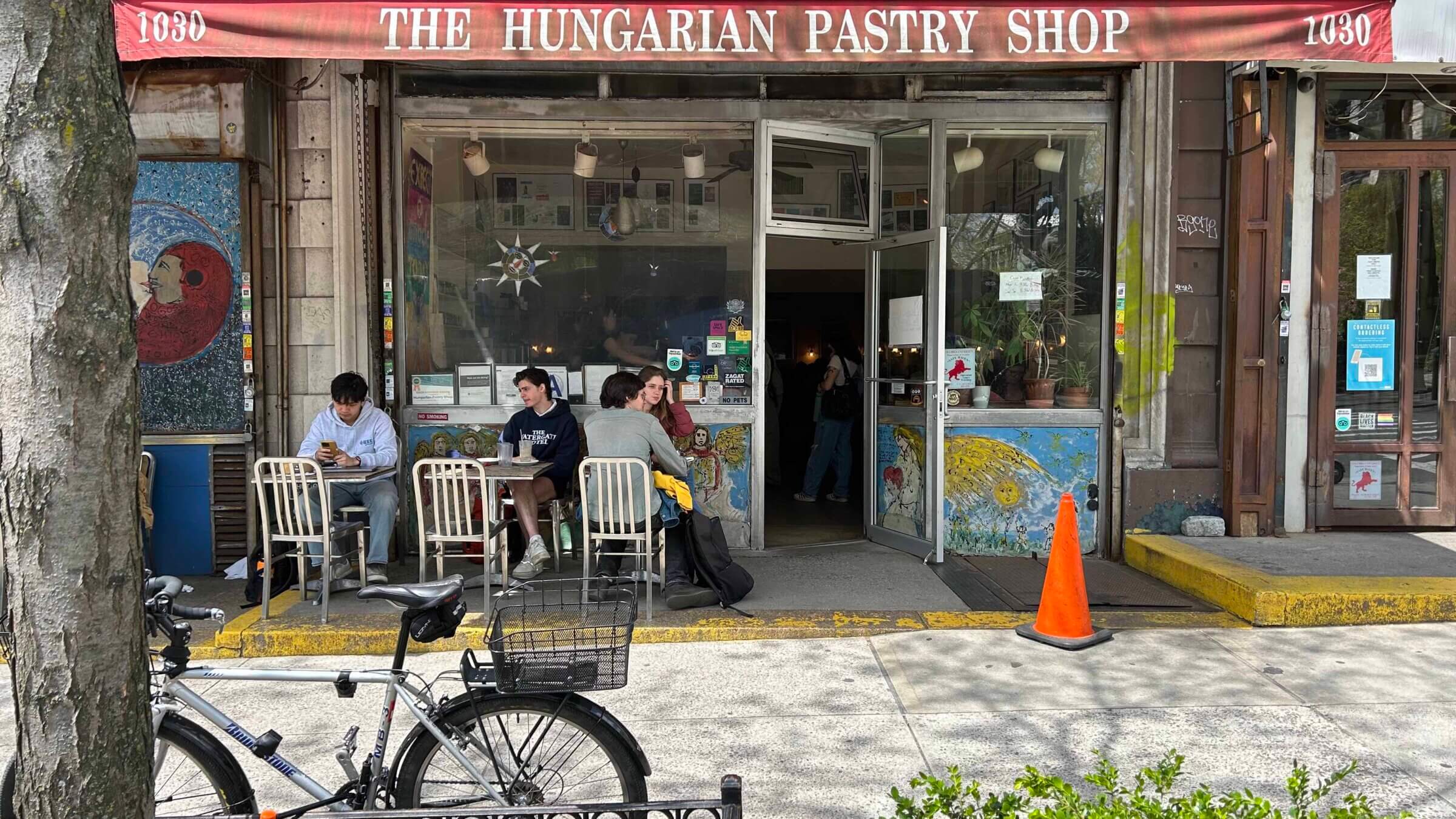Columbia’s campus is rocked by protests. The surrounding neighborhood? Not so much
Residents of Morningside Heights say it’s business as usual in their Upper Manhattan community

People sit and chat outside the Hungarian Pastry Shop, a popular cafe a few blocks away from Columbia’s campus in Morningside Heights. Photo by Sam Lin-Sommer
Columbia University has been making headlines since April 17, when students set up a pro-Palestinian encampment that they called a “Liberated Zone.” There have been arrests, a constant police presence, politicians swooping in and holding press conferences and calls for the resignation of the school’s president, Minouche Shafik. At schools across the nation, at least 13 camps have sprouted up in solidarity with Columbia’s protesters.
And so it would be easy to think that Columbia’s tumult would send shockwaves through the Morningside Heights neighborhood in which it is situated. But instead, from interviews with locals and a stroll through the area, life seems to be going on as normal.
Many Morningside Heights residents carried on with errands and trips to coffee shops. But despite the mundanity of daily life, when I spoke with them on a visit to the neighborhood this week, none wanted to offer their full name in connection with the chaos at the nearby campus.
For them, the only reminder that they lived in the direct vicinity of protests garnering nationwide attention were the sounds of helicopters overhead. “I watch TV over the air,” said Craig, a 71-year-old man who lives in a senior center a few blocks from campus. “Helicopters break up the signal.”
He said that besides interruptions to his television viewing, phone conversations with friends about the war and the hubbub he witnesses at Columbia’s entrance when riding the bus up Broadway, he hasn’t noticed any tangible changes to his daily life since the protests erupted.
I heard something similar from Asi, a 63-year-old retired information technology worker who lives less than a two-minute walk from the entrance to the section of campus closest to the encampment.
“The way the news covers it, you get a sense of, ‘Oh, this is something pervading the whole atmosphere,’” Asi said.
The reality on the ground is a little more boring. “If it weren’t for the reporting,” Asi said, “I’d scarcely be aware of anything going on.”
On a visit this week to Morningside Heights, I walked down quiet, tree-lined side streets, and avenues where patrons at cafes commented on the warm spring weather. I didn’t bump into any activities related to the protests. Generally speaking, people seemed to continue with business as usual.
Of course, some signs of the events in the periphery were inevitable. Security was heightened at Columbia’s entrances, with police standing guard alongside university personnel. Metal barricades were set up on the wide sidewalks, preventing people from loitering.
At the Hungarian Pastry Shop, a popular cafe a few blocks from campus, several diners wore kaffiyehs, and one of them talked with friends about what seemed to be advice on dealing with police.
While I ate a club sandwich at the counter at Tom’s Restaurant, the diner that was a stand-in for Monk’s Café on Seinfeld, a middle-aged man further down the counter spotted a woman he recognized as Rikki Schlott, a New York Post reporter, and struck up a conversation with her about the encampments.
After she left, he told me, on condition of anonymity, that he is a retired Columbia administrative assistant. He doesn’t live in Morningside Heights, but he was visiting the area around his old workplace to run an errand and catch a peek of the action on campus. He said that the neighborhood’s reaction to the protests was in line with what he had seen in his years working at the university, which is often home to demonstrations.
“I was afraid,” he said, that the neighborhood “might be crowded, with all the people on campus.” It wasn’t.
A Jewish sophomore named Benjamin, who had protested the arrest of students by the New York Police Department, was the only person who I talked with who cited signs of unrest in Morningside Heights. Though he emphasized that the interactions with other students were not as tense as the media might portray them to be, the heightened police presence did make him feel on edge.
When I asked Ron Maimon, an Israeli physicist catching up on work while eating at the Hungarian Pastry Shop, whether he felt the reach of the protests in everyday life, he replied, “God, no.” He added that he didn’t believe that any blatant instances of antisemitism existed in New York, before or after the protests.
At the pastry shop, most people seemed to be engaged in the things that the cafe is known as a bastion for: drinking coffee, eating pastries, reading, doing work on a laptop and engaging in spirited discussion with friends.
Asi, who had come to read Don Juan by Lord Byron, said that “things are far more ordinary and peaceful than folks might gather, you know, reading the news.”
Contrary to popular belief, he joked, you don’t have “people going at one another with clubs.”
A message from our CEO & publisher Rachel Fishman Feddersen
I hope you appreciated this article. Before you go, I’d like to ask you to please support the Forward’s award-winning, nonprofit journalism during this critical time.
We’ve set a goal to raise $260,000 by December 31. That’s an ambitious goal, but one that will give us the resources we need to invest in the high quality news, opinion, analysis and cultural coverage that isn’t available anywhere else.
If you feel inspired to make an impact, now is the time to give something back. Join us as a member at your most generous level.
— Rachel Fishman Feddersen, Publisher and CEO